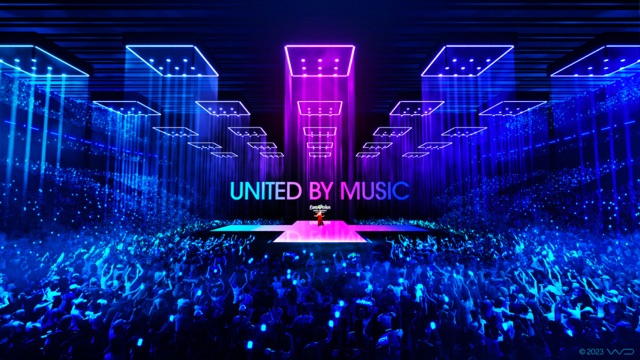If there’s one thing that Eurovision Song Contest fans can always count on Swedish broadcaster SVT to do when it hosts the Song Contest, it’s to experiment and innovate with the form and function of the Contest.
The community received an early Christmas present with the release of our stage design for Malmö 2024, and… wow! We have not been disappointed.
Whilst the movable LED cubes, LED floor and cutting-edge stage technology is all very impressive, what’s most striking about the Malmö 2024 stage is that the production team has opted to do something which many people in the community have hoped for, but no host has fully committed to implementing; placing the stage in the middle of the standing audience.

Eurovision stage concept for Malmo 2024 (EBU / SVT)
Eurovision In ‘The Round’
From the images we’ve seen of the stage so far, the back wall of the arena will have the traditionally large LED screen but with only a thin strip of the stage at the base. The main stage is a large cross-shaped structure around which standing audiences in the arena will crowd all around, the closest thing that the contest has ever seen to a Eurovision Song Contest taking place in the round.
This design means delegations this year will be forced to think outside the regular theatrical box stage when crafting their staging and shot list. Whereas traditional stages tend to be surrounded by an LED wall and banks of lights with only one clear angle onto the audience, artists will now mostly perform with audiences on all sides.
Delegations may choose to use the LED cubes that can presumably drop for the ceiling, but these aren’t as big as a traditional LED wall. Delegations may choose to bring dancers but will have to navigate the non-traditional shape of the main stage. Delegations may choose to play safe and keep their performers on the narrow strip at the back of the stage… but how forgiving will the camera be to these choices, and how will these acts still manage to generate an atmosphere in the arena if they’re not as geographically close to the audience as many other performances?
I expect to see a lot of influence from the theatrical direction of ‘in the round’ performances. However, the Song Contest has another aspect to consider… how the performance will look to those watching at home.
SVT’s choice of stage is bold and won’t be to the liking of all artists, broadcasters and fans. Yet the impact will encourage risk and creative thinking from all delegations; it also means we are set for a Song Contest that visually is like nothing we’ve experienced before in Eurovision history.









